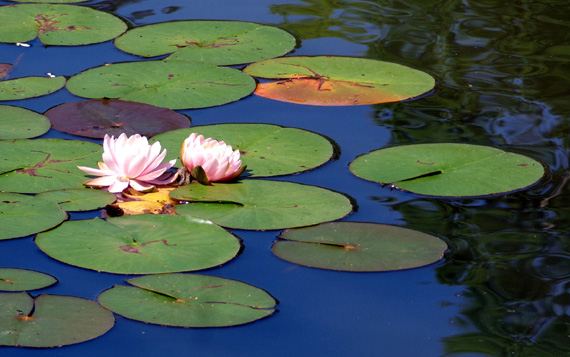When so many other Boomers are selling their houses to RV full time why
did we decide to do just the opposite -- put our RV in indefinite
storage and buy another house after being happily house-free for the last three years??
Because so many other Boomers are selling their houses to RV full time!
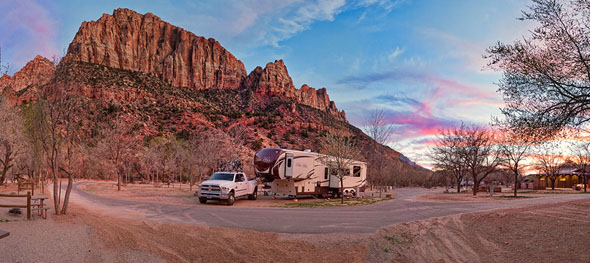
As if. The dream advertised by GoRving.com.
For us, and some other folks who've been RVing for several years or
decades, the current glut of new people discovering the joy of traveling
in a camper has caused enough problems to modify our lifestyle
once again. It's gotten too frustrating to find campsites where we want
to visit, requiring an inordinate amount of planning far in advance, and
RV parks, campgrounds, parks, and even boon-docking sites are simply too
crowded.
Good luck finding an empty campground in a scenic spot like the one
shown in the photo above. That used to be possible up until a few years
ago but isn't likely any more.
OUR MORPHING CONCEPT OF "HOME"
Stick-built houses or our rolling residence . . . "home"
has been wherever Jim, our two (three, as I write this) lovable Labrador
retrievers, and I were living at the moment.
While enjoying both extended and full-time recreational vehicle travel
the last thirteen years I've been saying, "Home is where our camper
is parked," whether that was in California, Alaska, Nova Scotia,
Florida, or anywhere in between.
During part of that time we also owned a house in Virginia but we spent
a lot more time in our rolling residence than in that stationary house.
Oddly, our HitchHiker and Cameo 5th-wheel coaches felt more like "home"
than the house, regardless of where the camper was parked at any given
time.
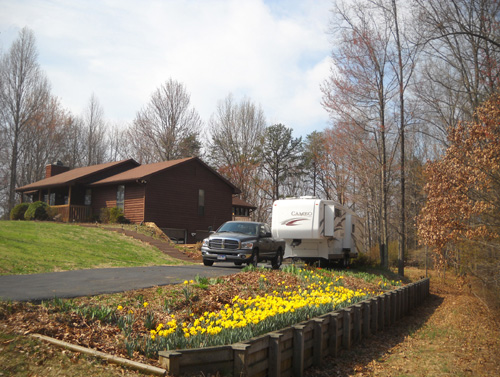
Big house, little house: truck and Cameo at our Virginia property in
2011
In the 2016 year-end journal entry I mentioned that we were searching
for a suitable stix-n-brix house to buy in either Peachtree City, GA or back in the
Roanoke, VA area. Long story short, we did find an almost-perfect house
for us in Peachtree City and closed on it at the end
of March.
This was a big step for us after living primarily in a 5th-wheel for
so long.
Although we had a nice house with twelve acres of woods in Virginia for
ten of those thirteen years, we were seldom there to enjoy it. Instead,
we were traveling around the USA and Canada in the camper for four or
five months at a time, returning to the house in the spring and fall to
check up on things for a few weeks before heading out again --
usually out West, many miles from Virginia.
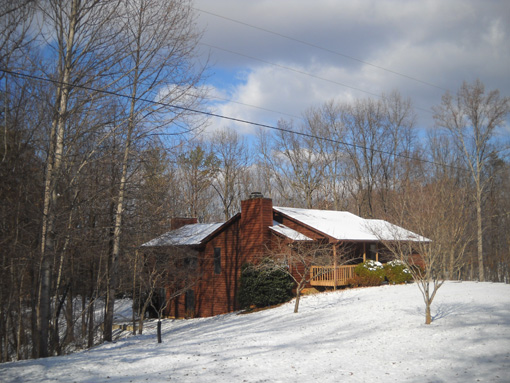
We tried to avoid snow in the winter but a couple of times we didn't get
going until too late!
If it hadn't been for the Great Recession, we would have sold that
property in 2009 instead of 2014. Selling the house at a loss when the market
tanked was not part of our retirement plan so we waited.
When the housing market recovered sufficiently in that area of the
country, we did sell it and traveled full time in our RV for three years with our two
Labrador retrievers, Cody and Casey. We were literally all over the map. They've
each been to more states and provinces than most humans!
FREEDOM FROM "STUFF"
When we sold our property in Virginia three years ago we had no idea how
long we'd be house-free. We sold or gave away most of our furniture and
other belongings and stored the rest.
It's amazing how liberating it is to live with less. The more things we
sold or donated, the easier it was to get rid of more "stuff." In fact, after three
years we forgot most of what was in our storage unit -- we had a
list and photos for insurance purposes, though -- and it was so
simple living in the camper with only what we could store there.
Housekeeping was also a lot easier, and there was no yard work.
The freedom was awesome and we loved being able to go where we wanted,
when we wanted, within some limitations.
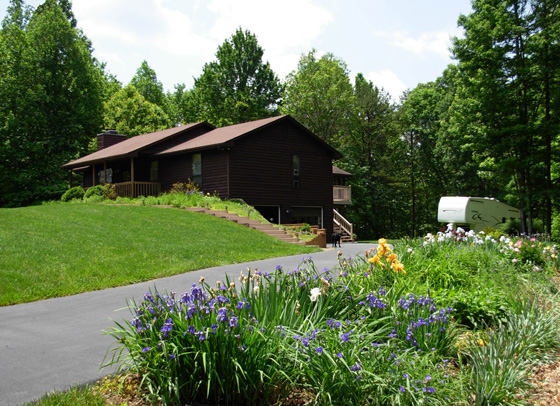
The yard in Virginia required a lot of work but I loved all the
perennials, grass, and trees.
There were some things we missed about not having a stationary
residence, however -- no sense of belonging to a neighborhood or
community, not being anywhere long enough to do meaningful volunteer
work, a lack of medical continuity for us and the dogs.
I also missed gardening (except for the weeding!) and having all my craft and sewing supplies and
equipment with us.
Lack of space wasn't a real problem for us in the camper. Although our living
quarters were much smaller than in a house, our 36-foot 5th-wheel coach
with three slides had plenty of room for us and two dogs to be
comfortable. We spent a lot of time outdoors and we made sure there was
plenty of "outdoors" wherever we traveled.
Small house, big yard.
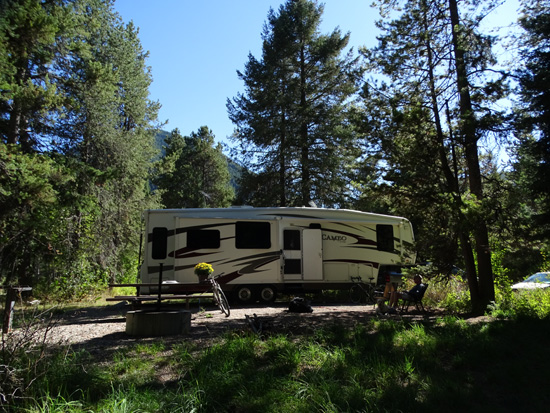
One of our favorite campsites is in the Targhee National
Forest on the east side of the Tetons.
There are fabulous
wilderness trails nearby, high up in Alaska Basin.
We knew at some point between two and twenty years that we'd buy another
house somewhere. What we couldn't predict until recently was when,
where, and for what reason(s).
We always hoped it would be a mutual decision and not driven by an
emergency. The decision turned out to be completely mutual and not
because of a disaster of some sort. We both just "knew" this winter that
it was time for another permanent home base.
THOSE DARN KNEES!
Many older full-time RVers give up the lifestyle for medical reasons.
That turned out to be one of our reasons, although not the
primary one at the time we made our decision last winter.
After Jim had his partial knee replacement in December, 2016, I knew it
would be hard for me to recover in a small rolling residence with five
steps -- in a campsite and RV park somewhere that might have
uneven grass and gravel to walk on -- when I required two
total knee replacements.
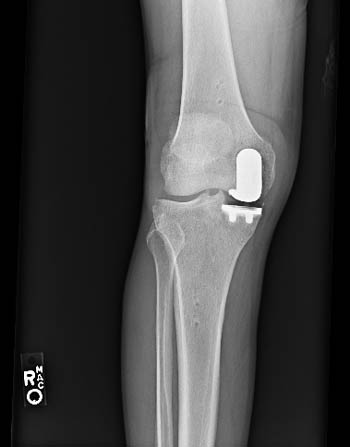
X-ray of Jim's knee after partial knee replacement; a total knee
replacement removes a larger area of bone and requires a longer
recovery.
I've been lucky to have put off knee surgery for eight years.
Visco-supplementation -- gel injections -- have been very
successful for me. However, I knew the time was rapidly approaching that
knee replacements would be necessary because the gel and interim
cortisone injections no longer worked as long or as well the last couple
years.
Turns out, a few months after moving into our house it suddenly became
necessary for me to schedule my first knee replacement. My knees really
hurt and it was too soon for either gel or cortisone for another three
months.
I'd run out of other viable options. Dang it.
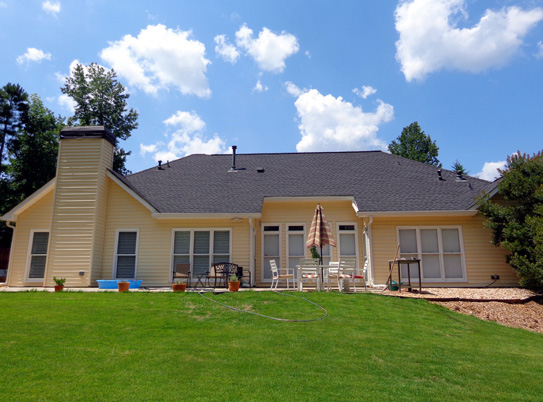
The back of
our house in Georgia; the yard is sloped but the patio is flat and long.
I'm writing this entry in September, several days after surgery on the
first knee, grateful that I have a stepless ranch house where I can safely walk inside and
outside to speed my rehabilitation. We have mostly hardwood floors
inside, a long paved driveway in front, and a concrete patio extending
across the back of the house for lots of smooth, flat walking. The
streets and multi-use paths are also paved. I"m just starting to walk
on those.
Who knew our timing
to buy a house would be so fortuitous?
THE EXPLOSION OF
RVing
But there was another over-riding reason why we decided last winter to
start looking for another house to buy and reduce our RV travel --
the increasing popularity of RVing!
The frustrations snuck up on us
like the proverbial frog in boiling water, a little bit at a time, until
it just wasn't fun any more.
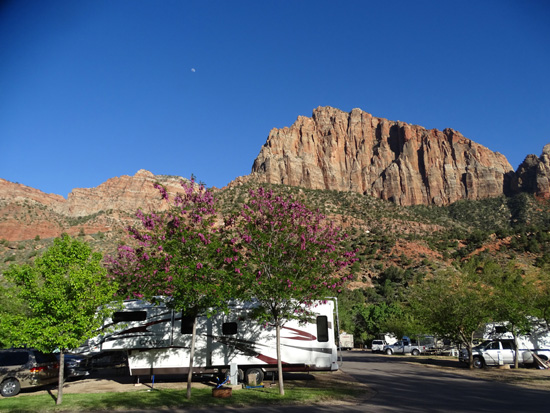
We were lucky to get this site in mid-April, 2016
at a private RV park just outside Zion NP;
we had more difficulty getting a reservation for
the fall because of record crowds in the area.
Thanks to the
economic recovery in recent years and the dramatic increase in the
number of Baby Boomers and younger folks traveling in RVs,
much of the thrill of living full time in our camper has diminished.
This lifestyle has dramatically changed in the last thirteen years we've
(mostly) enjoyed it.
No, we're not snobs who just want to be at the forefront of new trends
and move on to something else when the novelty wears off or our current
favorite activity becomes too mainstream.
Thousands of folks were full-time RVers before we were. We were part of
the problem ourselves, adding to the ranks of retirees and other people
who wanted more freedom to explore this great continent of ours in a
little house on wheels that could go where we wanted to go.
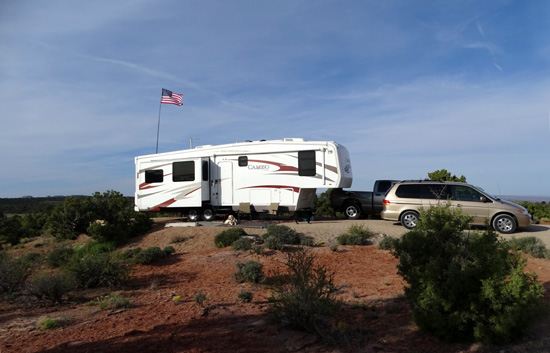
Campgrounds in the Moab, UT area were both
expensive and full in late April, 2016 so we
headed up the nearby plateau to Horsethief Natl.
Forest Service CG, where we found this nice site.
Times have changed pretty quickly.
So many more people have chosen a house-free lifestyle in the last couple of
years that it has become less of a novelty and considerably more common.
Of course, not all retirees want to sell their houses and
drive off in a motorhome to travel around the country. Many just want to
get out for a few weeks or months at a time to see new places, check off
travel-related items on their bucket list, and visit friends and
relatives.
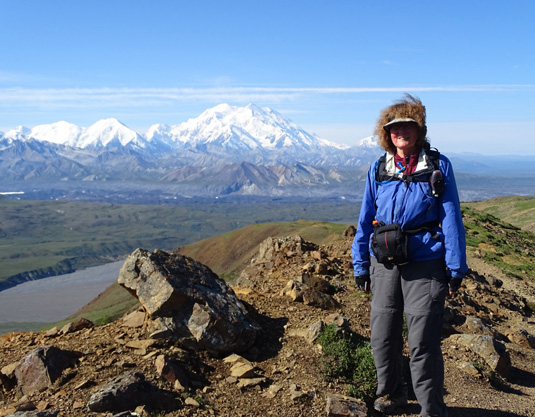
Alaska was on our bucket list so
we spent two fabulous summers there. This is me on the ridge
above the Eielson Visitor Center
at Denali NP, with Denali in the background. (July, 2015)
It's not just Baby Boomers who are snapping up RVs in record
numbers in 2016 and 2017.
Since the economy has improved over the last several
years, younger folks feel much more financially stable and are adding to
the frenzy. Lightweight entry-level travel trailers are the hottest RV segment now
because they are more affordable than most motorhomes or 5th-wheels.
Most Gen Xers and Millennials use their rigs just for vacations. An increasing number
are living full-time in them, however, while
continuing to work in occupations they can do from anywhere they have a
reliable internet connection. We've met quite a few younger RVers who
travel, with or without kids they home school, while they earn a living
on the road and chalk up memories to last a lifetime.
WHAT'S THE PROBLEM?
Sounds great, doesn't it? Well, keep reading.
About 430,000 new RVs rolled off the assembly lines in 2016 in the
United States and the prediction is for about
550,000 to be manufactured this year. Sales have increased in Canada,
too. For the past several years the RV industry has set a new record each
year.
That's great for RV manufacturers, employees, and dealers. They are
ecstatic. However, it's not so great for consumers.
So what's the problem?
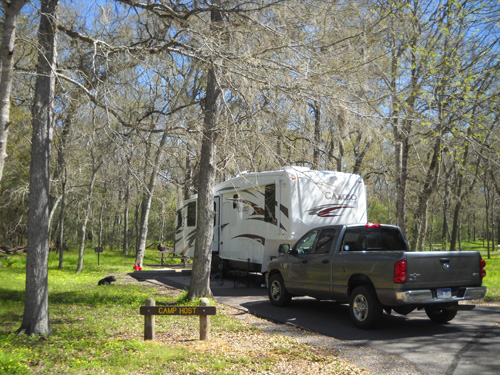
Our new Cameo, in a camp host
site at Brazos Bend State Park
in Texas a few weeks after we
bought it (March, 2010)
For one thing, an increasing number of these new motorhomes and
trailers are poorly made due to haste and lousy quality control.
You can expect some issues the first couple of years with any new rig
but there are increasing problems with new RVs in recent years, even the
more expensive ones. They are simply being cranked out too fast, in an
effort to meet
the demand, and the manufacturers and dealers don't care if they fall
apart after the sale.
To compound this problem, there are not nearly
enough qualified, trained technicians to repair these substandard rigs in a
timely manner when something goes wrong that the owner
can't fix. I keep reading horror stories of excited new RVers whose
motorhomes and trailers spend more time waiting to be fixed than out on the road.
And the RV industry rigorously fights strengthening lemon laws so they are
comparable to the ones for passenger vehicles.
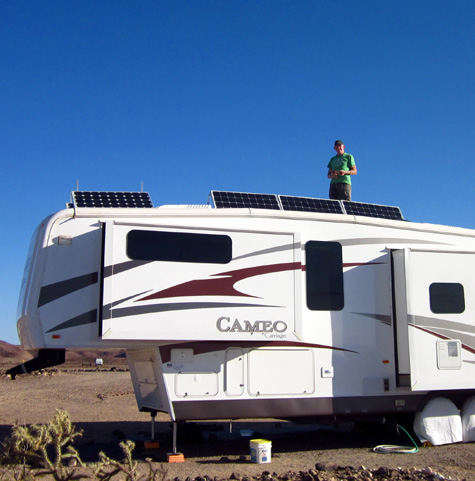
Jim swapped out the old solar
panels for new ones in early 2012,
and made tilting brackets to
follow the sun's path.
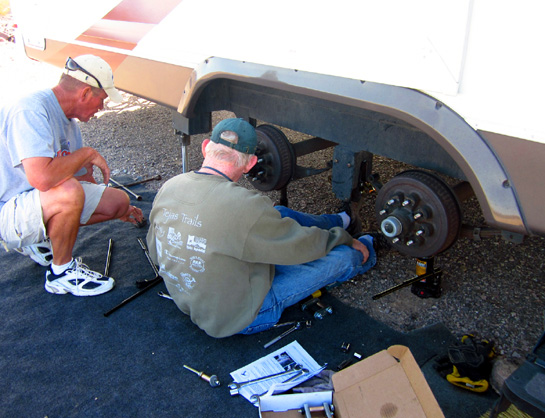
Jim got "help" from a curious
nearby RVer when he installed shackles and wet bolts in 2012.
He's done a lot of other maintenance
and upgrades himself, including disc brakes in 2015.
We purchased our new 2010 Carriage Cameo fifth-wheel coach during the
recession. Because dealers were having trouble selling the RVs on their
lots, we got a good deal on it and didn't run into
too many problems with warranty work the first 21 months before Carriage
went out of business (it had been around for 42 years prior to
that).
Jim has been able to maintain and repair everything since then,
fortunately. Otherwise, we would have come off the road even sooner.
If we needed to have work professionally done now, we'd be screwed.
Not only does it take a very long time for busy repair shops to do the
work, we also have an "orphan" RV since Carriage went bankrupt. Suitable
parts could be difficult to find.
WHERE WILL THEY ALL PARK?
The biggest problems for us the past few years has been
overcrowding and difficulty getting campsites when and where we want them.
Simply put, there aren't nearly enough campsites in this country
(or Canada) to accommodate all the new RVs being sold each year PLUS all
the existing RVs that people like us are still using.
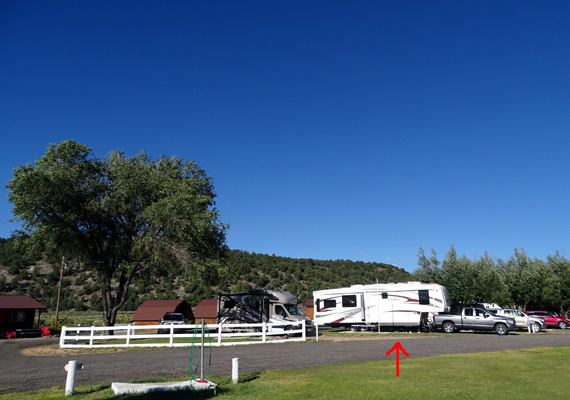
When we were unable in 2015 and 2016 to find a
suitable campsite at or near Bryce Canyon NP
we stayed a month at a time, for three different
times, at a nice private RV park several miles away.
Sites in many popular RV parks and campgrounds, especially those in
state and national parks, must be reserved months or a year in advance
and even then, it's not a slam-dunk because some sites are gone in a
matter of seconds when they first become available online.
We have spent an inordinate amount of time the last couple of years
tweaking our travel plans in an effort to find suitable RV sites in
areas where we want to go, sometimes giving up the idea when it was
simply impossible.
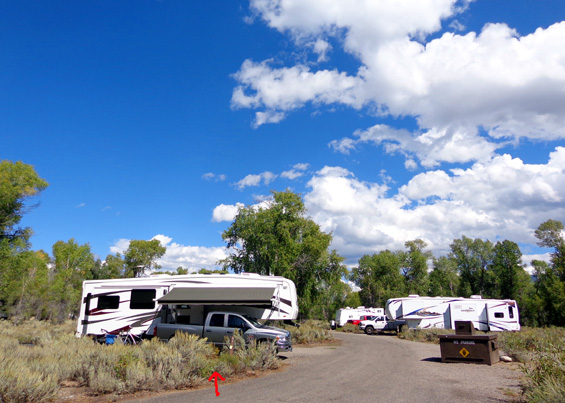
We were lucky to get this
campsite in uber-popular Grand Teton NP in Sept., 2013
but changed our plans last fall
when we couldn't get a spot near there again.
We miss the spontaneity and relative campsite privacy we had when we
first began extended RV travel in 2004. The fun factor significantly
diminished in recent years.
Even though we liked to have a general travel plan each year, and even
some reservations, by the end of 2016 it had become so frustrating and time-consuming
to find nice campsites in places where we wanted to spend time that most
of the fun and adventure had gone out of the process.
Ironically, it became more difficult to figure out where to travel
after we sold our house. We weren't planning around ultra races any more
and we'd already been to a lot of places we wanted to visit. Going back
to the house was always a "default" mode if we had trouble finding good
places to camp or something went wrong with the Cameo or truck.
Jim joked a couple times last summer, "Maybe we should just buy
another house" so travel planning would be less complicated and we'd
have somewhere to land temporarily or permanently, if necessary.
We weren't quite ready yet at that point to buy a house but we agreed
as early as last July that we needed to start thinking seriously about
where we would want to spend the rest of our lives in case we had to
make a quick decision for some reason. That was really the beginning of
the end of full-time RVing for us
PACKED LIKE SARDINES
Meanwhile, let's talk about another major problem with so many people
buying RVs now.
If you can get a campsite, most RV parks and campgrounds are
packed and resources like good WiFi connections are stretched. That's occurring as much in military
campgrounds as in private and public ones.
We have run into that problem all across the U.S. and Canada. Here's
an example of a site we occupied -- briefly -- in Moncton,
New Brunswick in 2014 because it was our best option while we visited
the north end of the Bay of Fundy:
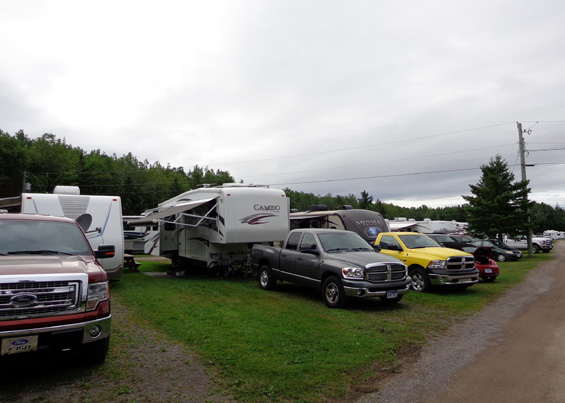
We don't like having such a
narrow site that there is barely room to put out our awning
and the neighbor's sewer
connection is next to our picnic table. How disgusting!
This past winter at Kings Bay Sub Base in southern Georgia our
campground was at capacity almost every day from November to March, with
as many as a dozen RVs in overflow at a time. We've never seen it that
crowded in three prior winter stays in that campground.
Even remote boon-docking (dry camping) sites on BLM land
and national forest campgrounds out West are becoming so crowded it's
difficult to get a good spot to park with some privacy.
The LTVA at Imperial Dam in southern California, e.g., was noticeably more
packed two winters ago than it was when we camped there several years
before that. We were at the nearby Yuma Proving Grounds military
campground the winter of 2015-6 but rode our bikes and hiked at the LTVA several times a
week, watching as it became more and more crowded.
Here are two pictures that vividly illustrate my point:
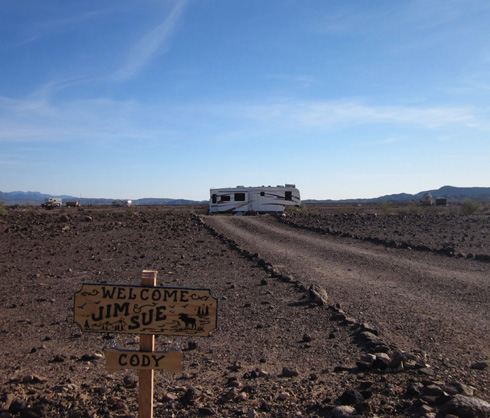
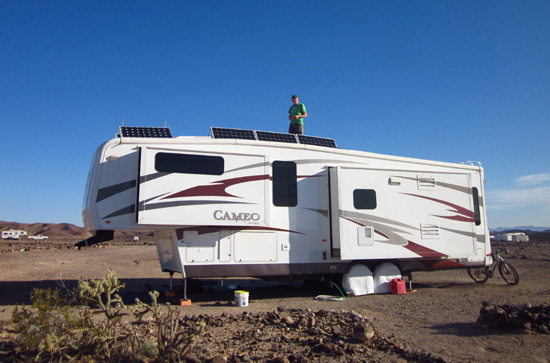
The first two pictures above show our camper occupying about an acre of land
in January of 2012.
The next view from the site behind it is the
same plot of land in early 2016 when six or seven RVs occupied the same circle:
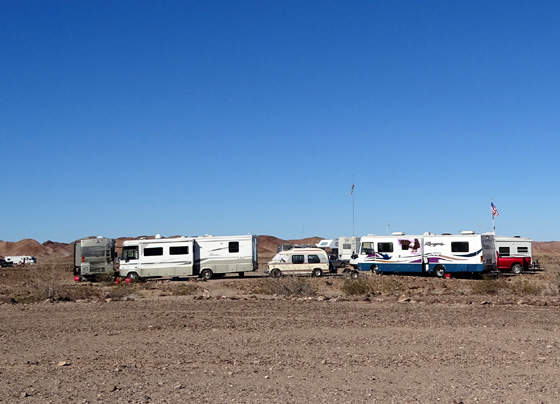
The whole place was significantly more crowded in 2015-6 and probably
worse this past winter when we chose to snowbird in southern Georgia
instead of Arizona. Many folks like us camp at remote boon-docking sites
for privacy, not to sit on top of our next door neighbors.
Going to national parks has become less fun for us, too, simply
because they are so crowded. All of the more popular parks like Zion,
Yellowstone, Grand Teton, Grand Canyon, and Yosemite have set attendance records each year
in recent years.
Not only is it almost impossible to get a campsite in or near these
parks, it's also difficult to get around inside the parks on the roads
and trails if you're lucky enough to have scored a campsite or motel
room. What used to be off-season or shoulder season months are just as
busy now as prime season at some parks like Zion.
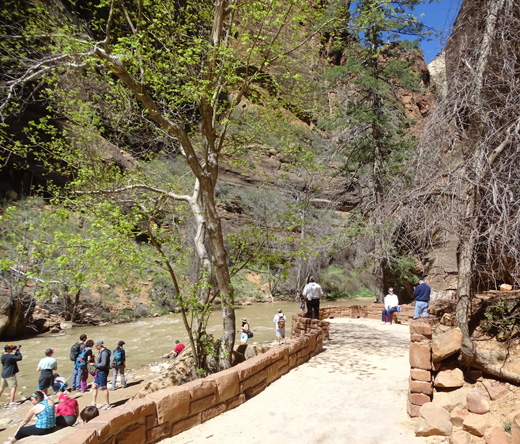
Even though the popular "Narrows"
canyon was closed to hiking in early April, 2016
due to high, fast water in the
Virgin River, plenty of people hiked the River Walk Trail.
We visited Zion in early spring, 2016 but it was so crowded on the
buses and trails that we decided to go back to Bryce Canyon in the fall
instead. It was our third trip to Bryce in a year. On days we hiked or
rode our bikes in either park we quickly learned to arrive very early to avoid crowds and
find a parking place.
Zion is now considering limiting the number of people who enter the
park on the busiest days.
THE THRILL IS GONE . . .
. . . for us, at least temporarily, and for many other folks who've
been RVing for a while and have seen changes that affect them adversely.
For folks new to RVing, I think the anticipated fun will soon wear
off when they see how hard it is to get campsites where they want to go
and they begin to have the inevitable repairs one can expect with a new
rig the first year or two.
Other unexpected expenses will creep up, too, including the cost of
RV storage. More and more communities won't allow people to park their
RVs on their own property. (We bought a house in Peachtree City this
year with full knowledge that we can't park the Cameo in our yard like we did at
our rural Virginia property. We save money by keeping it at a military
base about 90 minutes away.)
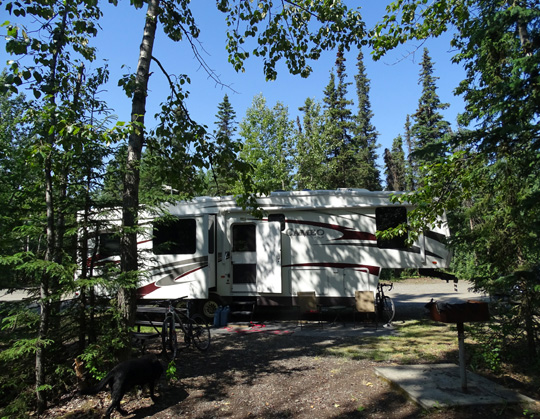
When we were full-time RVing we
didn't have to worry about where to store the Cameo,
just where to park it at each
destination. This is a site at JBER in Anchorage, AK in June, 2015.
Another problem is that many of the newer RVs rolling off the assembly lines are
quite long, with four or five slide-outs and lots of special features
that require 50-amp electrical service.
Size matters. The larger the RV, the fewer campsites are available
out there, the harder it is to park the rig, and the more difficult it
is to maneuver it through traffic and fuel stations. It's hard enough
with our moderately-sized 36-foot 5th-wheel; I can't imagine what
it's like to haul a 42-foot trailer.
Public campgrounds are particularly ill-suited for these large rigs,
often having only 20- or 30-amp power (or no electricity or water
hookups at all), older style short and narrow sites, and roads with
tight turns or overgrown trees that are difficult to negotiate. Most
state and national parks don't have enough operating money for routine
maintenance, let alone additional funds to build more or bigger
campsites.
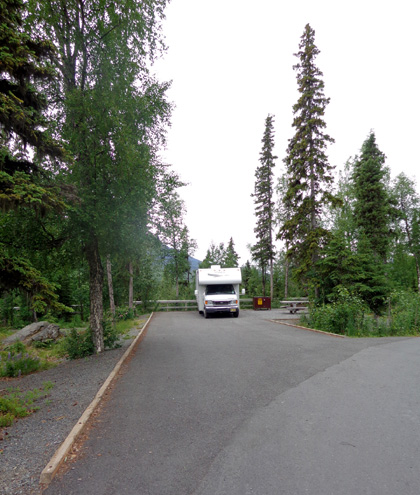
Note to people with smaller RVs:
Please be considerate and don't choose
a large site like this if there
are nice ones available to you that are smaller.
New private campgrounds and RV parks are very expensive to build, too, mostly
because the cost of land has sky-rocketed in desirable areas. And nearby
landowners often don't want a campground near them so they object to
rezoning.
Another trend is actually reducing the number of available
campsites in some places. For example, KOA, the largest chain of campgrounds,
has been removing some RV sites to put in Kamping Kabins, which
are more profitable for the franchise owners. Others are putting in
yurts and similar structures for "glamping."
Does any of this sound like fun for full-time RVers, let alone all
the families that just want a nice site for their next one-week vacation??
I predict that a whole bunch of used RVs are going to be up for
sale in another year or two when people get so frustrated with current
conditions that they just give up and try to unload their expensive,
unpaid-for rigs.
BEEN THERE, DONE THAT?
Not totally, but almost.
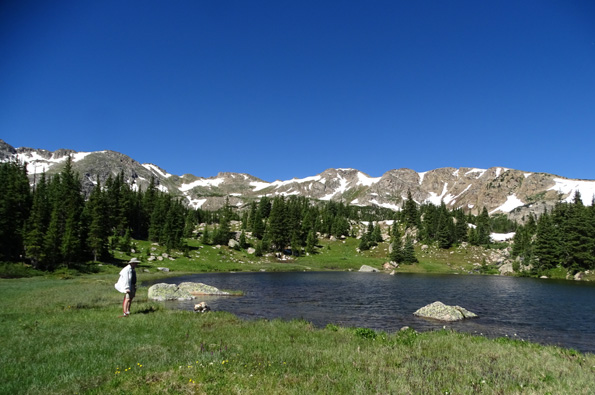
I've lost count of the number of
times we've been to Leadville. CO since 1998. Because of the
awesome natural beauty and
numerous things to do, we'll continue going back again in the future.
Jim and I have had the opportunity to travel extensively the past
thirteen years in two different 5th-wheel coaches. The past three years
we lived in our comfortable Carriage Cameo full-time, without the stress
of worrying about a stick-built house while we wandered around the U.S. and Canada.
Our style of travel morphed over those years, from moving more
frequently at first to attend the ultra-distance foot races we ran and
visiting lots of places that were new to us . . . to spending
more time in fewer locations so we could explore them more thoroughly and
less frenetically. We always had a nice mix of favorite places we'd
enjoyed previously and new places that were on our "bucket list."
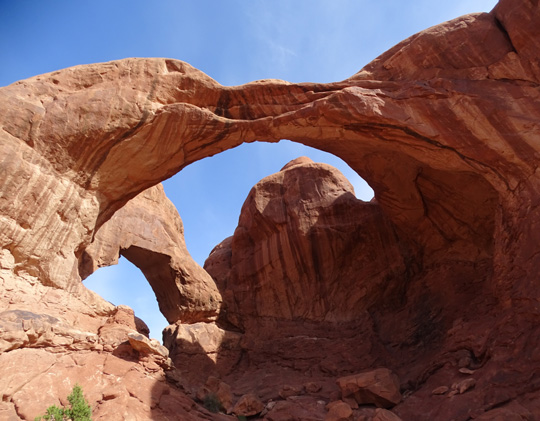
We visited several national parks
in 2016 that were new to us, including
Arches (above), Canyonlands,
Death Valley, Joshua Tree, and Capitol Reef.
We've been to most of the locations in North America that really
interest us, some repeatedly. There will always be more places we want
to explore but none of them jump out right now as "gotta go there soon."
As I write this in late September (ignore the date at the top of this
entry!) our RV has been in storage almost six months and neither of us
has had any urge to go get it and take it anywhere. It's been a very
busy year and now I'm recovering from the first of two total knee
replacements. If we really wanted to go somewhere I'd put the second
knee off until next year -- but we don't.
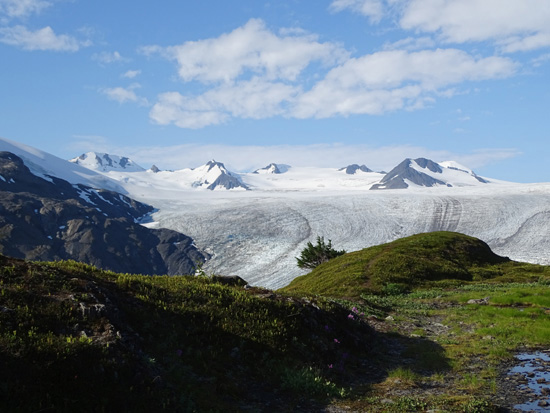
Someday I want to go back to
Alaska for a third summer. I'd love to hike up the trail
by Exit Glacier to the Harding
Icefield (above) again. (July, 2015)
I doubt we'll sell the Cameo any time soon. As long as we keep it in
good condition we can get it ready relatively easily to go on another trip somewhere
when the urge strikes again.
After six months of living in our new house we have no regrets about
the decision to buy it and postpone further RV travel indefinitely.
We've enjoyed having houses before, then we enjoyed traveling full-time in
the Cameo, and now we enjoy our current lifestyle as we put down roots in a new community.
"Home" is still wherever we and our fur kids live, not what kind of
structure it is.
Next entry: our house-hunting process
Happy trails,
Sue
"Runtrails & Company" - Sue Norwood, Jim O'Neil,
Cody, Casey, and Holly-pup
Previous
Next
© 2017 Sue Norwood and Jim O'Neil
